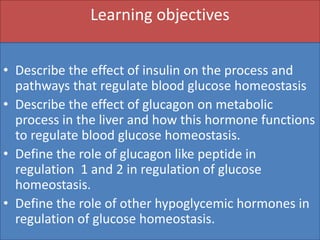
1051 carbohydrate metabolism lecture 9 (1)
- 1. Learning objectives • Describe the effect of insulin on the process and pathways that regulate blood glucose homeostasis • Describe the effect of glucagon on metabolic process in the liver and how this hormone functions to regulate blood glucose homeostasis. • Define the role of glucagon like peptide in regulation 1 and 2 in regulation of glucose homeostasis. • Define the role of other hypoglycemic hormones in regulation of glucose homeostasis.
- 2. • Compare and contrast type 1 and type 2 diabetes mellitus. • Recognize the clinical presentation of type 1 diabetes mellitus and discuss the diagnostic criteria. • Describe the abnormalities in blood glucose homeostasis in patient with type 1 diabetes & discuss the metabolic derangements.
- 4. • The pancreas has two major types of tissues: the acini (secrete digestive juices to duodenum) and the islets of Langerhans (secrete insulin and glucagon directly into blood) ♦Alpha cells secrete glucagon • elevates blood glucose concentrations ♦Beta cells secrete insulin • reduces blood glucose concentrations ♦Delta cells secrete somatostatin • slows the rate of food absorption and digestive enzyme secretion • Close interrelation among various cell types allow regulation of secretion of some hormones by other hormones: • insulin inhibits glucagon secretion, somatostatin inhibits insulin and glucagon secretion
- 11. • ♦ Mechanism of Action of Insulin: • The insulin receptor is a combination of 4 subunits held together by disulfide linkages: two -subunits lying outside the cell membrane and two -subunits protruding into the cell cytoplasm. • When insulin binds to the -subunit in target tissues, the -subunits in turn become activated. • Activation of the -subunits triggers a series • of reactions that draw the glucose transporter to the cell membrane. • Cells of various organ tissues like liver, muscle, adipose are now able to increase their uptake of glucose (w/in seconds after insulin binds with its membrane). • The cell membrane also becomes more permeable to many amino acids.
- 12. • Summary: Metabolic Effects of Insulin • Increases rate of glucose transport into target cell • Increases rate of glucose utilization and ATP formation • Increases conversion of glucose to glycogen (liver, skeletal muscle) • Increases amino acid absorption and protein synthesis • Increases triglyceride synthesis (adipose tissue) • *DECREASES HIGH BLOOD GLUCOSE LEVELS* • (Insulin is anabolic hormone)
- 14. REGULATION OF BLOOD GLUCOSE
- 15. • Blood sugar is very finely regulated as it is essential to have a continuous supply of glucose to the brain • FBS = 70-110 mg% • RBS= 100-140 mg% • Factors which regulate blood sugar are— o Rate of supply of glucose to blood o Rate of removal of glucose from blood
- 16. • Factors which contribute glucose is to blood • Absorption from intestine • Glycogenolysis • Gluconeogenesis • Glucose is obtained from other carbohydrates
- 17. • Factors which remove glucose from blood • Hepatic glycogenesis • Muscle glycogenesis • Oxidation of glucose • Lipogenesis • Synthesis of non-essential amino acids
- 34. METABOLIC CHANGES IN TYPE1 DM
- 50. TYPE I DM • ONSET- Usually during childhood or puberty • Symptoms develop rapidly • Seen in undernourished • Genetic predisposition- moderate • Beta cells are destroyed eliminating the production of insulin TYPE II DM • Frequently after the age of 35 • Symptoms develop gradually • Obesity is usually present • Strong Insulin resistance is combined with inability to produce appropriate amount of insulin
- 51. TYPE I DM • Autoantibodies are frequently found • Ketosis- Common • Acute Complication- Ketoacidosis • Response with oral hypoglycemic- Unresponsive • Treatment– Only insulin TYPE II DM • Rare • Rare • Hyperosmolar non ketotic coma • Responsive • Diet f/b exercise/ oral hypoglycemic and if failure occurs-- Insulin
- 54. • Maintaining Control • Protect heart, nerves, blood vessels, eyes, and kidneys by controlling blood glucose level. • Maintain schedule for checking blood glucose level and taking insulin. • Maintain well-balanced meal plan, exercise program, and healthy weight. • How does exercise help? •Most of the time muscle tissue depends on fatty acids for energy • Under two conditions muscles use large amounts of glucose: – During moderate or heavy exercise (muscle fibers become permeable to glucose even in the absence of insulin– important in Type I) – During the few hours after a meal (while pancreas is secreting more insulin– important in Type II). – Most of the glucose is stored as muscle glycogen.